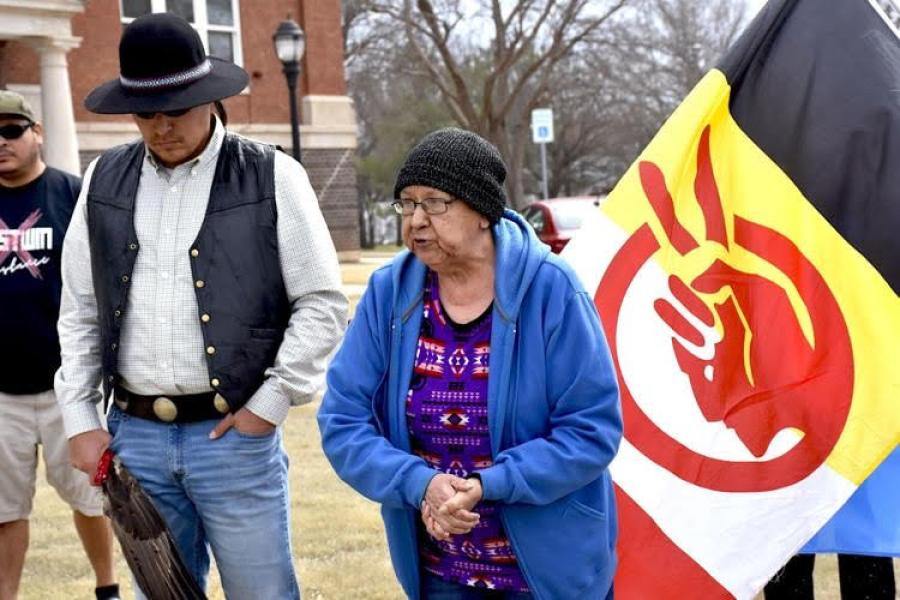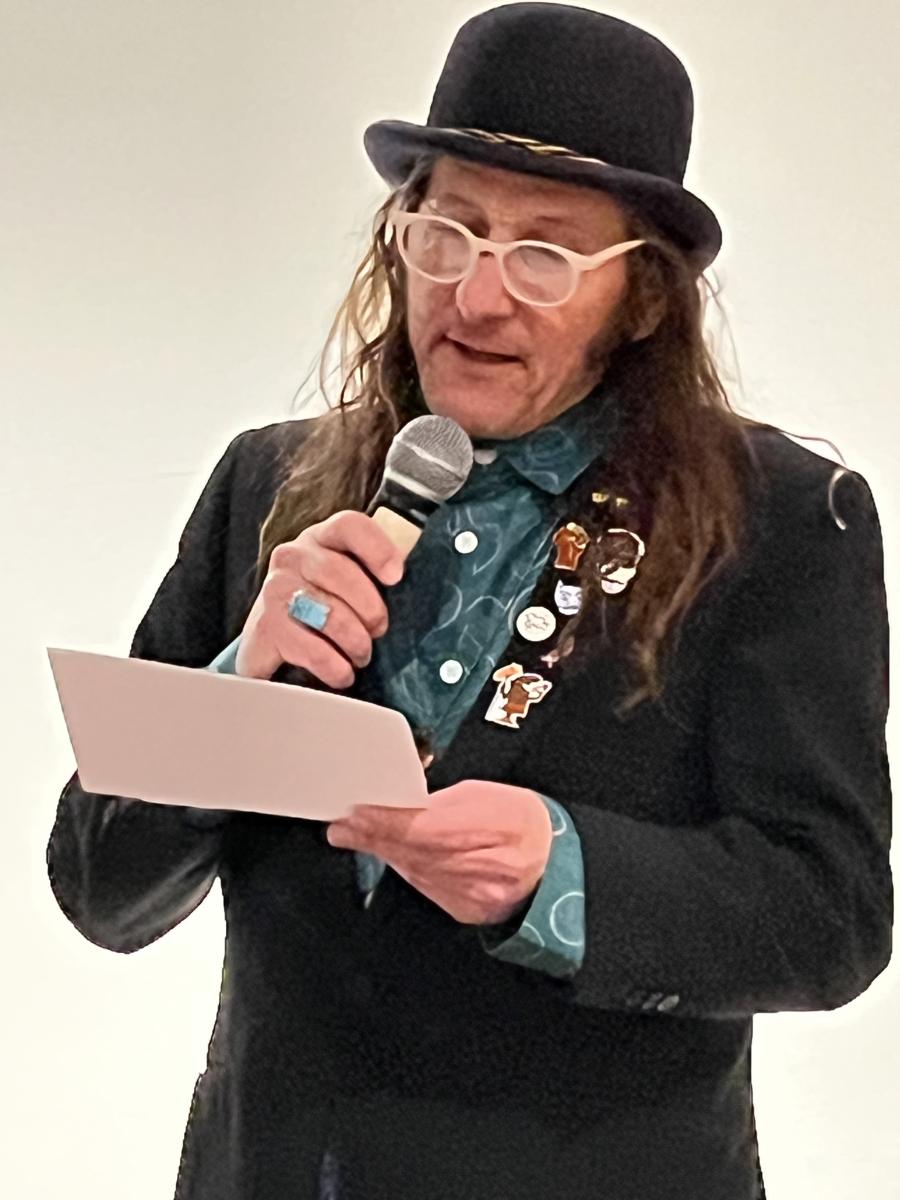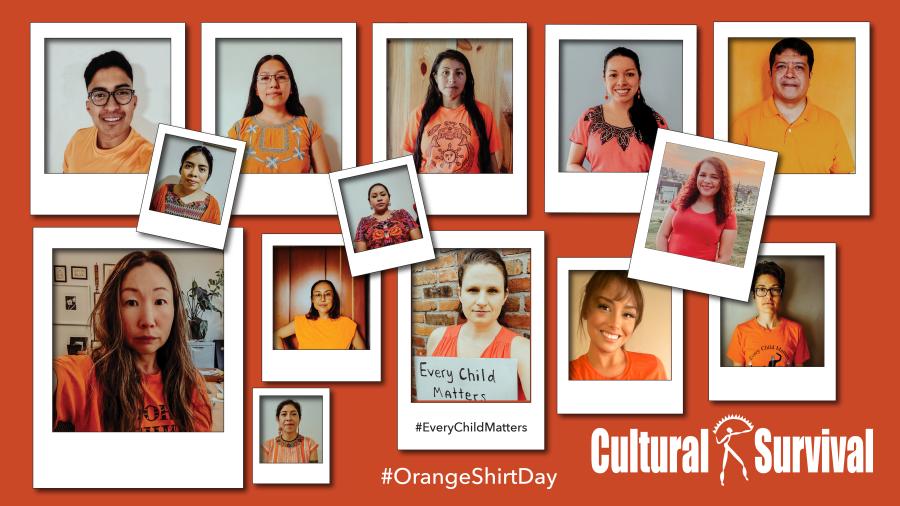On the lands of the San Carlos Apache in southeastern Arizona, a fight continues between Apache Tribal members and two multinational mining giants over the proposed extraction of copper. At stake is the site of Chi’chil Biłdagoteel, known in English as Oak Flat, which has, and continues to, represent a sacred landscape for the Apache. Apart from Oak Flat’s role as an environment for prayer and medicinal plant gathering, this landscape is particularly important as a site where young Apache women take part in coming-of-age ceremonies. These significant cultural and spiritual relationships that Apache people actively maintain with the living landscape of Chi’chil Biłdagoteel make it difficult for many Apaches to accept the proposed plans by Resolution Copper to build one of the largest copper mines in the world. Adding to the gravity of the situation is the fact that the proposed block cave mining technique to access the copper ore would obliterate the mountain, turning it into a two-mile-wide crater on ecologically diverse federal lands that are part of the Tonto National Forest.
Based on increasing political and popular support for what have been labeled “green” energy transitions(renewable energies and technologies that move away from carbon), certain transition metals, including copper, lithium, cobalt, and nickel, are deemed critical because they are required components in manufacturing batteries for electric vehicles and related technologies. As countries throughout Europe and the United States race against China for dominance in the electric vehicle market, the conversations and plans around obtaining the supplies of necessary minerals have become more urgent. Yet, in the eyes of numerous Indigenous communities, as well as an increasing number of environmental scientists, these plans are fraught with risks and unacceptable consequences.
As a result of the threats to Oak Flat, members of the San Carlos Apache Tribal community created the Apache Strong- hold, a nonprofit organization that fights for Oak Flat and Apache relationships with this sacred site. Apache Strong-hold has been the leading party in a lawsuit against the U.S. government aimed at preventing the transfer of this land— which has immense religious and cultural importance to Apache people—to the mining companies. And while the struggle at Oak Flat points to the deep, sustained relation- ships Indigenous Peoples have always had to the lands where copper can be found, many Indigenous Peoples have also long had significant relationships to the copper itself.
In Oklahoma Indian Country, one does not need to travel far in any direction to find strong relationships between Native people and copper. Beginning with the Caddos, one of the original Tribal Nations to have called present-day Oklahoma part of its traditional homeland area, the story of connections to copper can be seen as layered, complex, and enduring. A critical set of perspectives on these traditional and present-day relationships to copper comes through the voice of Tracy Newkumet (Caddo/Delaware), a highly accomplished traditional regalia maker and artist with decades of experience across sewing, beadwork, jewelry making, and clothing design.
Between approximately 1000–1450 AD, Spiro was the seat of a highly sophisticated cultural community that was closely linked to trade through the Arkansas River, and by extension, the Mississippi River. Copper played a central role for the community at Spiro, particularly as seen in the diverse and intricate copper headdresses, repoussé plates, ear spools, axes, needles, and beads. In certain cases, objects such as masks and rattles were covered in copper. Many of the copper repoussé plates were adorned with dancers in specific regalia, hawks, and unique geometric motifs. The ingenuity shown in the diverse array of uses for copper is a testament to the traditional value of the metal for the people of Spiro, both in terms of the practicalities of everyday life, as well as in use for ceremonial and spiritual functions.
Centuries later, throughout the period of contact with European traders and settlers, Caddo women, along with numerous other Tribal Nations of the eastern woodlands, began to wear the dush-too— a black, hourglass-shaped headpiece worn by women that is often embellished with metal studs, beads, or mirrors and long, flowing ribbons of water silk that are also adorned with metal, mirrors, or bells. German silver, which is an alloy of nickel, copper and zinc, is the most common metal for studs and medallions on dush-toos.
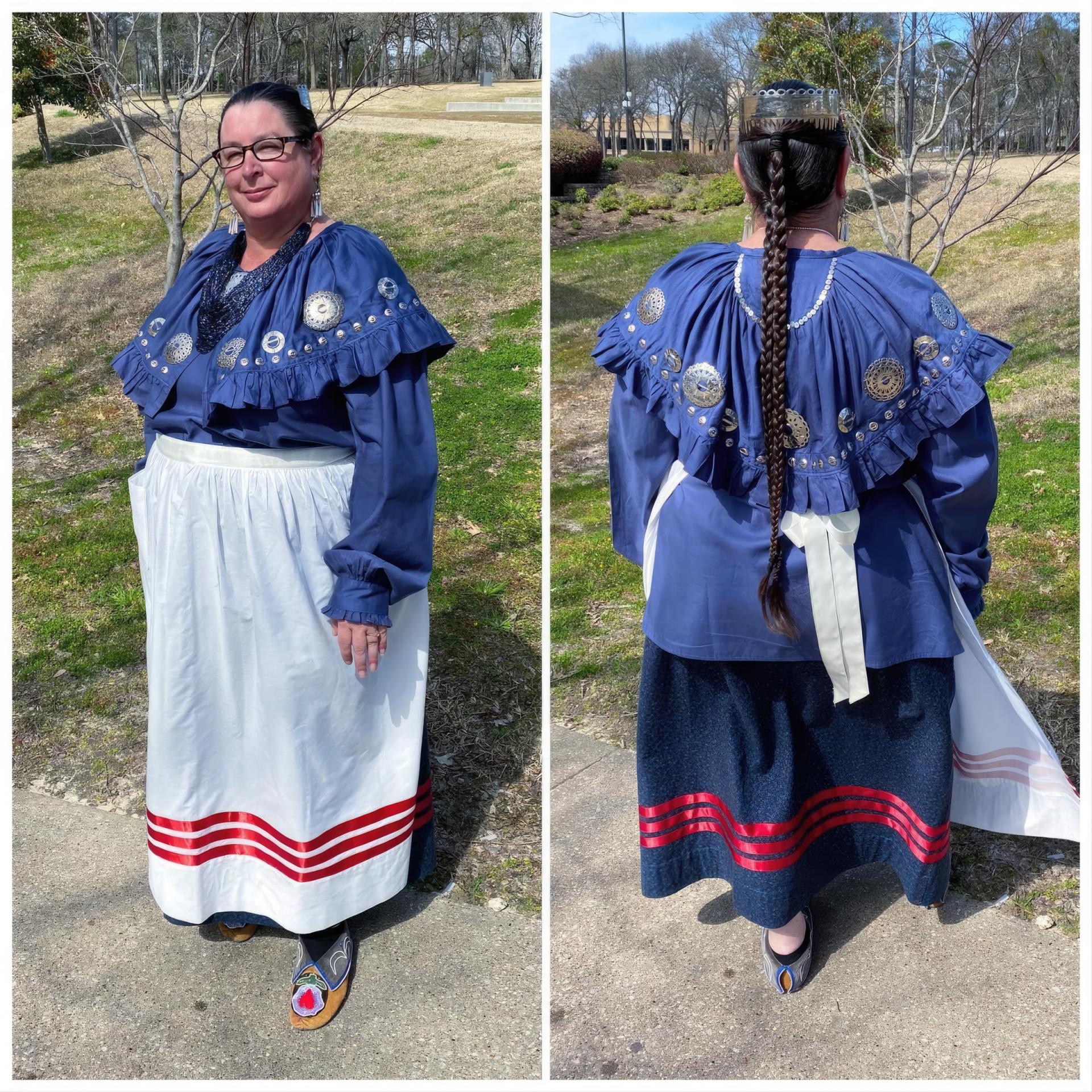
Artist Tracy Newkumet (Caddo) wearing her regalia. Photo by Tracy Newkumet.
Newkumet points out that many of these new trade items, particularly alloys containing copper, were coming from Asia and the Middle East via the Silk Road. “The blending of cultures on the Silk Road all came together and directly benefited us as Native Americans,” she says. Newkumet’s emphasis on the importance of the Silk Road trade to Native Peoples is a perspective rarely heard in the dominant narratives of European influence and trade with Native Nations. In tying these connections together,she posits, “I can imagine a world in which our Native Peoples would have been able to trade and exchange without the intermediaries of European traders. I can imagine our communities, who really elevated these materials into something special for our Native cultures, interacting directly with those communities in Asia that produced these fine goods that traveled the Silk Road.”
Apart from the Caddo dush-toos, German silver hair combs, and brass bells that Newkumet uses, creates, and handles on a daily basis, her relationship with copper recently took a deeply personal turn. In the spring of 2019, a group of Caddo Nation Tribal members went to visit the Caddo Mounds State Historic Site in Alto, Texas for the site’s annual Caddo Culture Day. The area where the mounds are located is part of the Tribe’s traditional homelands and also the southwesternmost ceremonial site of their Caddoan ancestors. In the midst of the day’s activities a tornado struck the area, decimating the traditional Caddo grass house and the heritage museum, and injured numerous Caddo and non-Caddo visitors.
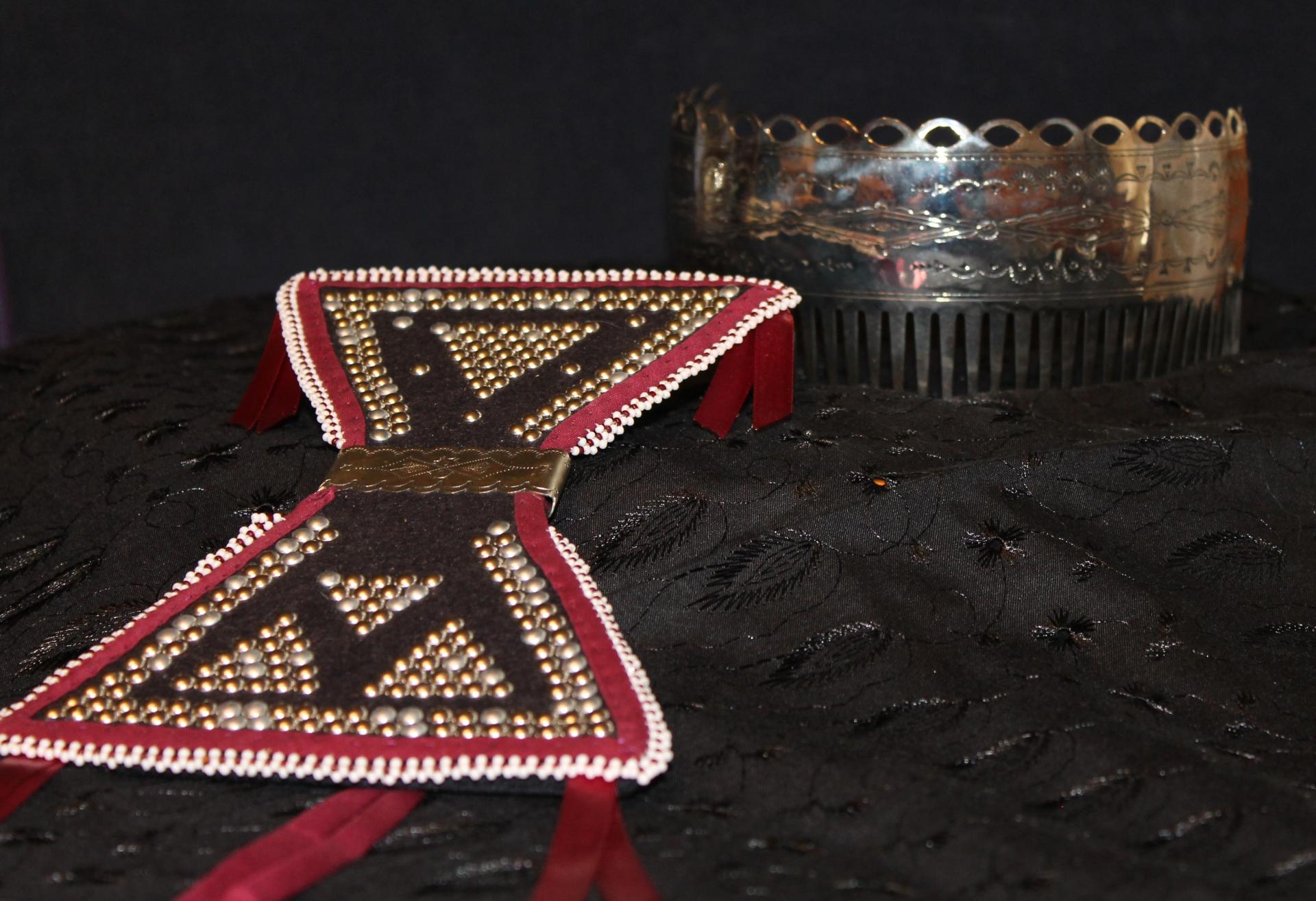
A detailed look at a Caddo dush-too and German silver head comb. Photo by Bobbie Chew Bigby.
Newkumet and her daughter were in attendance that day and experienced the devastation caused by the shahó (tornado). Afterward, Newkumet immediately noted that shahó had taken something else that she had deeply loved at the Caddo Mounds site—a large oak tree cherished by so many. She describes the tree, her “favorite tree on the planet... it had moss on its left side, like a human body where the heart is strongest on the left side. This tree had four sections and when you would look up at it from below, you could see how your heart would work with the four chambers.” Shahó had destroyed this oak tree, and with that, had added to the trauma and sadness experienced by the survivors.
With support from the Texas Historical Commission and inspired by Newkumet’s calls to commemorate the tree, planning for a tree memorial was started alongside the reconstruction of the museum and traditional grass house. Sculptor and metalworker Jason Youd was invited to create a steel tree that would memorialize the spectacular fallen oak, as well as honor those survivors of the devastation that occurred on that day. Newkumet made the special request that individual leaves made of copper be attached to the tree, with each copper leaf bearing the name of a survivor. Erecting this tree in the Snake Woman’s garden site at the mounds, Newkumet says her healing journey started from those copper leaves, on which she wrote her name and ‘Dóh Neshay’ (I keep going, keep trying).
Newkumet’s stories that connect copper’s cultural and ceremonial significance to Caddo people, both in the deep past and present day, share resonances with the spirit behind the Apache Stronghold movement and the value it places in honoring land, water, and all lifeforms. These histories show that Indigenous connections to all of creation, whether it is a transition mineral or the living lands upon which those metals are found, are layered, complex, and enduring. The struggle for Oak Flat continues through the ongoing lawsuit of Apache Stronghold v. United States to defend and honor the gifts of our living world.
Bobbie Chew Bigby (Cherokee) is a Postdoctoral Research Fellow at the University of Waterloo, Ontario, Canada, where she researches the intersections between Indigenous-led tourism and resurgence.
Top: A copper leaf from the memorialized oak tree signed by sculptor Jason Youd. Photo by Bobbie Chew Bigby.
